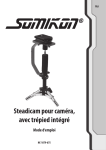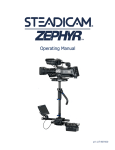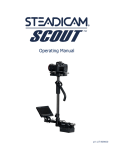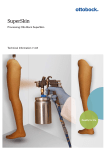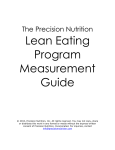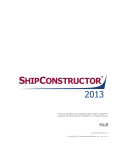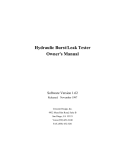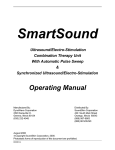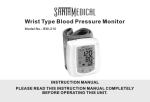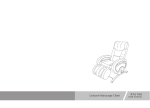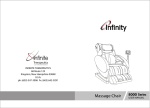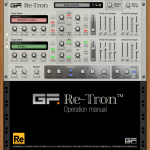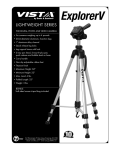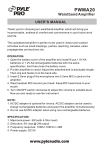Download Exovest User Manual
Transcript
Vest: Steadicam Fawcett Exovest ® p/n LIT-815780 Introduction The Steadicam Fawcett Exovest® is a semi-rigid exoskeletal vest that transfers the weight and torque of supporting a Steadicam into anatomically appropriate areas, without interfering with natural movement. Primary weight transfer is to the pelvis via four pads ergonomically placed around the waistband, and primary torque transfer is via a pad system at the upper back. Lower pads avoid compressing the abdomen in front, and the base of the spine in back. Upper pads avoid compressing the neck, shoulder joint, shoulder blades, and spine. Crucially, the absence of chest straps allows for unrestricted breathing and arm movement. Pad systems are connected by rigid sliding components, and tightened by double and triple-purchase straps for precise fit under load, so weight-bearing characteristics can be fine-tuned on the fly. The exemplary rigidity of the outer structure extends the torque-resisting lever-arm from mid-back (on existing vests) to high-shoulder level—halving the force required to counterbalance a Steadicam rig. Symmetrical twin-rod spars, rising fore and aft from the waistband, increase vertical range of the socket block—and uniquely, permit both front and rear arm mounting. Rear rod length clamp Socket block Four integral pivots allow the vest to conform to natural body movements. The rise and fall of the hips as weight is shifted from one leg to the other is accommodated by a lower pivot system, so the socket block remains level, and at the same height when walking—resulting in less muscular strain, and better overall stability and balance. The upper pivot system allows free movement of the shoulders. The resultant feel is of increased lightness and control. Between takes, the entire vest may be relaxed by means of one over-center lever, as the upper pad system beds in only under load. The Exovest ® is lightweight and less constrictive than conventional vests—allowing for better respiration, circulation, transpiration, and movement—and is especially comfortable for female operators. Waist velcro 2 Rear view The designer, Chris Fawcett, operates and teaches Steadicam worldwide and has extensively studied the physiology of human weight-bearing appliances. He is the author of Steadicam Posture. Front view Shoulder straps Shoulder latch Bridge plate Front rod length clamp Rear rods Socket block Waist velcro Waist latch Over-center lever 3 Fitting the Vest Note: The Exovest is a a radical new concept in Steadicam support. As such, it needs to be fitted well. This manual will explain how to put the vest on (bottom latch first), how to place the pads (on your pelvic bones), how to lift the rear rods off your back (booster pads), and how to get the pivot system to work with your body. To get the most from your Exovest, follow the directions below, and experiment with different settings until it conforms to the size and shape of your body. Once these adjustments are finalized, you can enter and exit the vest quickly by means of two latches and one over-center lever. 1. Fitting the Exovest Loosen the velcro straps at the waist and shoulders, and retag them leaving plenty of room to enter the vest. Roughly set the front and rear rod lengths, by eye, to the length of your torso. Open the shoulder and the waist latch and put on the vest, draping it over your shoulders. Closing the waist latch Close the waist latch by pushing the waistband with your left hand, and with your right hand, either pushing on the bridge plate, as shown, or by reaching under the bridge plate to pull the crescent-shaped plastic guide with your fingers. If the waistband is too tight with the velcro loosened, see the section Customizing the Waistband. Push the guide with the heel of your right hand to seat the dovetail, and snap the over-center lever shut. If it doesn’t close fully, open it again and push the guide farther. Fasten the shoulder latch. If it’s difficult to close, reseat the latch by loosening and re-tightening the two dovetail screws while wearing the vest. See the section: Customizing the Shoulder Straps for more details. Place the centers of the waistband pads level with the top of your pelvic bones. 4 Pad placement The four waist pads should rest on your pelvic bones. If you are broad across the pelvis, you may need to move the front pads further outboard so they do not sink into your abdomen. The pads should sit low, but you should be able to lift your legs sufficiently as to climb stairs without disturbing the vest. When you lift the Steadicam, the bulk of the weight should go into your pelvis, but allow a little stabilizing weight to rest on your shoulders—don’t leave a gap up there. When you push the Steadicam out in front of you, the rear rods should not touch your back. If they do, insert a booster pad between the back pad and the frame. Centering the rods Tighten the waist velcro evenly on both sides, so the rods are centered both front and back. Open the rod clamps, front and back (if you can’t reach them both yourself, ask for help), and snug the shoulder straps down onto your shoulders. Tighten the shoulder straps, leaving enough room to breathe deeply. Room to breathe Keep the rods off your back You should examine your posture in a mirror at this point. If the rods are touching your back because you are slouched forward, you may wish to correct this by standing up straight rather than by using a booster pad. Note: If you’re an experienced Steadicam operator, you’ll notice you are using different back muscles. This is because most vests resist the torque at mid-back level, necessitating that work be done entirely in the lower region of the back. By doubling this lever arm, we halve the force necessary to counterbalance the rig, and engage back muscles to the height of the shoulders. 5 2. Relaxing into the Vest Trim With traditional Steadicam vests, when walking, you need to hold your pelvis level to prevent the rig from pulling from side to side. In the Exovest,® you can walk normally, allowing your hip joints to rise and fall relative to one another. As you get used to relaxing your pelvis, you’ll feel the Exovest® working with your body. With the rig held comfortably in front of the centerline of your body, shift your weight sideways onto one leg, bringing the rig with you and remaining entirely upright. Now relax the stomach, back, and leg muscles that are holding your pelvis level so your unloaded knee bends and your unloaded hip joint drops. You will feel the pivot system shifting to accommodate this. Shift your weight, bringing the rig along, to the other leg, letting the pelvis rotate naturally as the other hip joint rises, again remaining entirely upright. Repeat this until you feel the pivot system working . Now bring this freedom of movement into a slow walk, and if you feel confident, even a slow jog. Get used to the feeling of the vest moving with you. You will soon find that, by freeing your pelvis, you will be able to move more smoothly and with less effort. Additionally, the socket block will remain at a more constant height relative to the ground. Operating in a good missionary or Don Juan position, with the rig held toward the centerline of your body, rather than off to the side, will increase the efficiency of the pivot system and reduce muscular strain while operating. If you have a short move that you’d normally do with your arms only, try broadening your stance, and moving your body with the rig instead. Face into the rig to keep it as much on your centerline as possible. Note: The small stopper block that restricts the rotation of the arm block to 180° aids with fitting and removing an arm to and from the vest, but many operators find that an arm functions better without it. Removing the stopper helps the arm to fold back out of the way as you cross the rig in front of your body. If you remove the stopper from a G70 arm, kick the aircraft-pin link forwards instead of backwards to increase reach. 6 3. Operating Adjustments 4. Customizing the Shoulder Straps By virtue of the double and triplepurchase velcro straps, you can tweak the force-placement characteristics of the vest without having to remove it. For convenience, retag the inner end of the waistband velcro so the outer end closes close to the front of your body where you can grasp it easily. If the shoulder straps are too wide or too narrow, or the dovetail latch is difficult to fasten, you need to conform the shoulder straps to better match your anatomy. Remove the vest, and slightly loosen the four allen screws at front (shown below), then slacken the shoulder velcro so you can slightly loosen the four allen screws to the rear. Shoulder strap placement Adjusting under load In between takes, relax the entire vest by releasing the over-center lever at the waist. Adjusting shoulder strap clearance Over-center lever in relax position If you require a low lens height, or simply prefer to have the socket block mounted lower than usual, you can set the bridge plate to jump over the lower pivot. Be advised that the further the Steadicam arm attachment point is from your own shoulder, the more likely you are to limit your boom range. (Goofy operators, see Section 6.) Bridge plate jumping lower pivot Fasten the shoulder latch securely, then release the front rod clamp to allow the front rods to find their own level. Now adjust the shoulder width by sliding the straps to left or right. Holding both sets of rods horizontal in their pivots, tighten the screws while maintaining a symmetrical distance between each shoulder strap and the centerline of the vest. If you can get someone else to do this for you, while you are wearing the vest, all the better. Note: If the shoulder latch becomes sticky after this procedure, reseat the latch by loosening and re-tightening the two dovetail screws while wearing the vest. 7 5. Customizing the Waistband Customizing The standard waistband will fit pelvic girths of around 28-48 in (71-122 cm). To allow the waistband to reach its full extension, on each side, move the small retaining screws at the inside of the rear waistband from their inboard to their outboard positions. For narrower waists, the waistband will function best with the center waistband strap retracted to the rear, and with these screws in their inboard positions. For special sizing requirements, please contact Tiffen. Retaining screw moved to outboard position. 6. Reconfiguring for Goofy Operators You can simply flip the bridge plate for goofy operating (rig to the right side of the operator’s body), but this puts the socket block on the same side as the over-center lever, and limits downward travel of the socket block as described in Section 8. To maximize utility, a goofy operator may reconfigure the vest to be the mirror image of a standard vest by moving both the shoulder and waist latches to the right-hand side of the vest. The screw-hole patterns in both the chest and abdominal plates are left– right symmetrical, so moving the latch hardware from one side to the other is quite straightforward. You’ll need a set of English Allen Keys to continue. Shoulder: 1. Remove the 2 screws that fasten the right-hand shoulder strap to the chest plate. Set the screws aside. 2. Remove the 2 screws that fasten the silver dovetail wedge to the left shoulder strap assembly. Remove the dovetail wedge, leaving the plastic handle and Velcro® strap in place, and move the wedge, using its own screws, to the right shoulder strap assembly. Keep the dovetail wedge in its original orientation to the vest. 3. Remove the 4 screws that hold the silver dovetail grabber and its strike plate to the chest plate and move these to the left side of the plate using the same 4 screws. Keep the dovetail grabber in its original orientation relative to the vest. 4. Screw the left shoulder strap securely to the chest plate using the 2 remaining screws. 5. Reseat the latch following the note on page 7. 8 Waist: 1. Remove the front pads. Unthread the Velcro® waistband straps from rear and the front rollers, on both left and right sides of the vest, but leave the Velcro® tagged to the center slides. 2. Pull both front plastic waistband slides clear from the rest of the waistband. 3. On the right-hand side of the waistband, remove the four screws that attach the plastic waistband slide, and its front roller, to the abdominal plate. Keep the slide, the roller, and its screws together. 4. On the left-hand side of the waistband, peel off the Velcro® backing strip behind the silver dovetail wedge, and remove the 2 screws that fasten the silver dovetail wedge and its strike plate to the abdominal plate. Move the wedge from the left to the right-hand side of the plate using the same 2 screws. Keep the dovetail in its original orientation to the vest, but mirror it left– right. Stick the Velcro® backing strip behind the dovetail wedge. 5. Screw the original right-hand plastic slide, and its roller, to the left side of the abdominal plate, using the 4 matching screws. 6. Fit the front slides into the rear slide assembly, and rethread the Velcro®. If it isn’t clear to you how to do this, please seek assistance. For someone with a little mechanical experience, it’s 20 minutes work to make a “full goofy” vest that is still friendly to regular-side operators. While standing in this position with the rig floating in balance in front of you, adjust your fore–aft threads such that, when looking from the side, you are leaning neither forwards nor backwards, but are upright, with the center of your shoulder girdle directly over the center of your pelvic girdle. 7. Posture Adjust your side-to-side threads such that, when looking from the front, you are leaning neither left nor right. The Exovest® is designed to work in conjunction with good operating posture. Now’s the time to check your form in a mirror. Do not allow your head to fall forward, but instead incline it downwards from the level of the top vertebra of your neck. This is the joint around which you nod, and is how you should tilt your head towards the monitor. Whether walking or standing, angle yourself approximately 45 degrees to the rig. Fore more posture information, please download Steadicam Posture from http://www.steadicam.com/steadicam_articles.html Above all, have fun, and fly safe. Tuck the rig in close to your center-line, and to your center of gravity. Stand up straight! 9 Notes 10 Notes 11 Patents pending. All trademarks are the property of their respective owners. Tiffen reserves the right to change specifications, accessories, etc. without prior notice. Designed and Manufactured in the United States of America ©2013 The Tiffen Company. Written by Chris Fawcett and L.Hayball The Tiffen Company, LLC 90 Oser Avenue, Hauppauge, NY 11788 Phone: 631-273-2500 • Fax: 631-273-2557 12 www.tiffen.com












